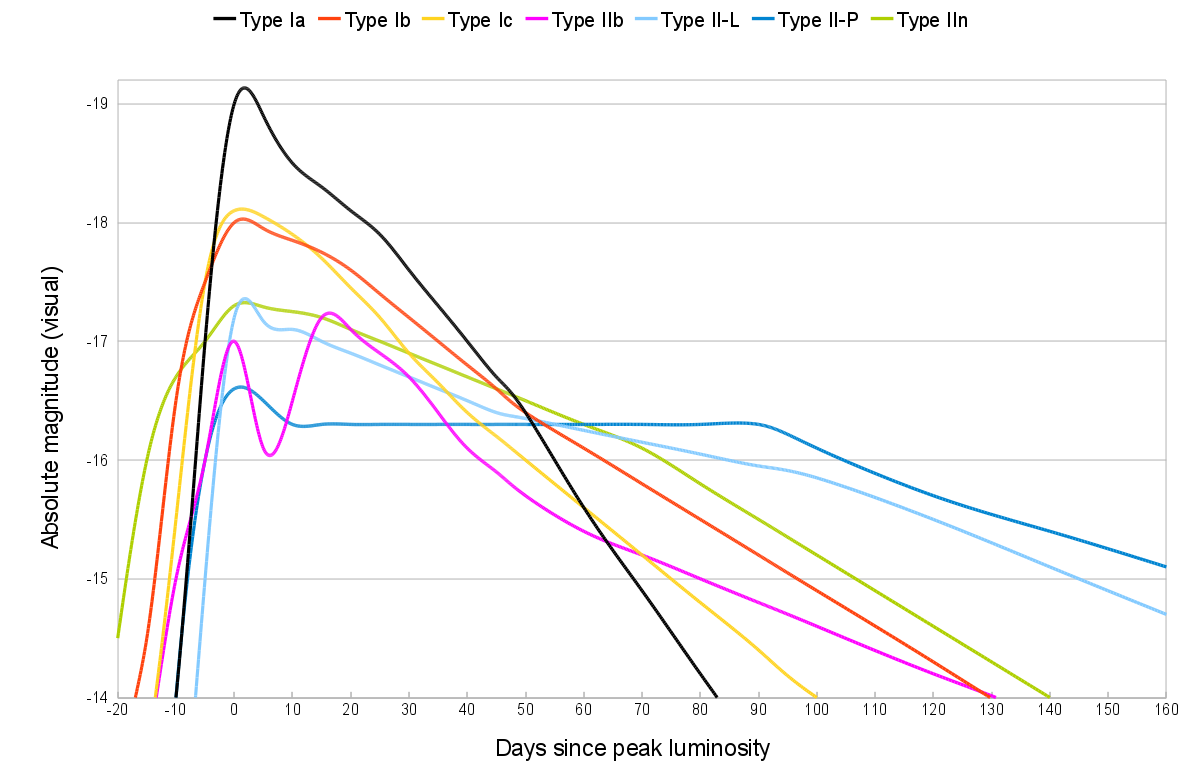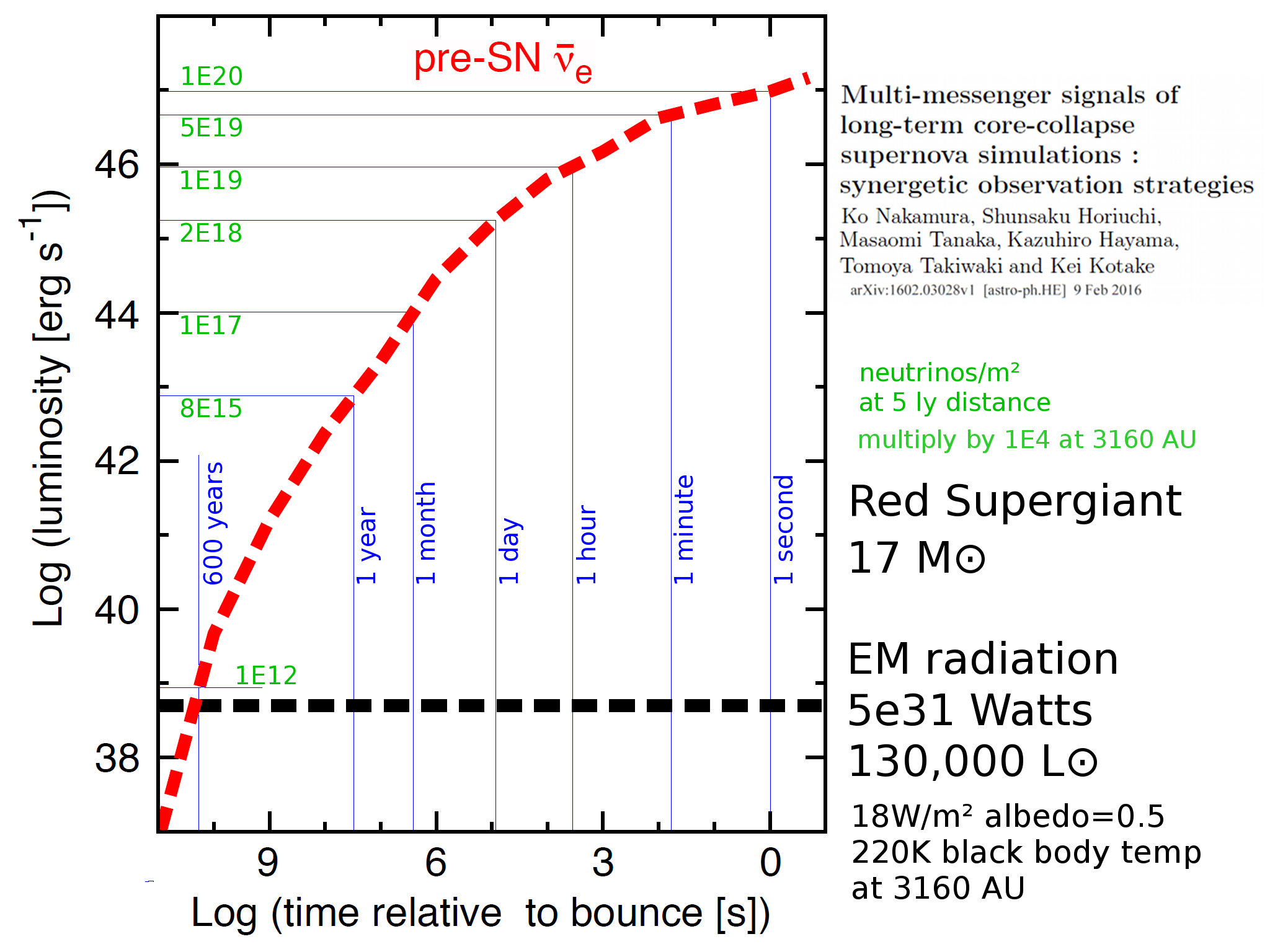Supernova effects on Server Sky and Stady Shell
The Sun's absolute bolometric (all band) magnitude is +4.74, 3.828e26 W, so an absolute magnitude of zero is 3.013e28 W.
Abs |
Watts |
10 pc |
100 pc |
Mag |
|
W/m² |
W/m² |
-19 |
1.2e36 |
100 |
1.00 |
-18 |
4.8e35 |
40 |
0.40 |
-17 |
1.9e35 |
16 |
0.16 |
-16 |
7.6e34 |
6.3 |
63m |
-15 |
3.0e34 |
2.5 |
25m |
-14 |
1.2e34 |
1.0 |
10m |
-13 |
4.8e33 |
0.4 |
4m |
gamma and X rays |
||
distance |
sn1a |
snII |
|
2e34W |
1e32W |
pc |
W/m² |
W/m² |
10 |
16.7m |
84μ |
30 |
1.86m |
9.3μ |
100 |
167μ |
840n |
300 |
18.6μ |
93n |
1000 |
1.67μ |
8.4n |
Type Ia |
2e44 J |
Supernovae Light Curves:
(by litopsian on Wikipedia)
- Stellar Interiors by Hansen+ QB808 H36 1994
- Table 6.3 p 247
- C + C → Ne + α 44% . . . C + C → Na + p 56%
- O + O → Si + α 21% . . . O + O → P + p 61% . . . O + O → Si + n 18%
- Thielemann and Arnett 1985 2x downloaded
- Truran 1966 (paywall)
- Bodansky Clayton Fowler 1968 2x downloaded
- Section 6.8 p251 Neutrino emission mechanisms
When temperatures are high enough - kT ~ 2 mec² photons creates electron positron pairs
- I have this book
Stellar evolution to supernova, and neutrino emissions
25 solar mass star |
|||||
Burning |
Required |
Required |
Duration |
Luminosity |
neutrinos |
Hydrogen |
4e7 |
5e3 |
7 Myear |
|
1.71 MeV per4 H |
Helium |
2e8 |
7e5 |
700 Kyear |
|
|
Carbon |
6e8 |
2e8 |
600 years |
|
|
Neon |
12e8 |
4e9 |
1 year |
|
|
Oxygen |
15e8 |
1e10 |
6 months |
|
|
Silicon |
27e8 |
3e10 |
1 day |
|
|
from "Extreme Explosions" by David S. Stevenson, Multco 523.84465 S84746 2014 |
|||||
- ee050 F 1.25 to 1.8 intrinsically variable, helium ionization heat/expand/cool/shrink Cepheid variables
- 1 to 50 day periods
- Delta Cephei is 5.366 day, mag 3.48 to 4.37, delta 0.87 or 2.23x
- ee059 at 1.5 GK oxygen fuses to silicon, phosphorus, then sulfur
Neutrinos: "1 light year of lead" is 9.5e15 m times 11,000 kg/m3, or 1e20 kg/m2. In the pre-supernova silicon-burning phase, core density is 3e7 g/cm3 or 3e10 kg/m3, so a 3 million kilometer column of core would absorb a substantial fraction of neutrinos.
AL26
The 1.8 MeV gamma emission of 26Al decay to 26Mn tells us about galactic frequency of Type II supernovae, about 2 per century , estimated from the gamma emissions from the 26Al around us, about 2.8 solar masses in the galaxy (5.6e30 kg). One supernova produces 2.5e26 kg of 26Al. The half life of 26Al is 717 ky, so the decay rate is 3e-14 per second, or 7e11 decays/kg-s, or 0.2 W/kg. Assuming 0.04 c radial velocity, and isotropic deposition at a distance of 100 light years (9.4605e17m) 2500 years later (0.25% has decayed), the deposited material density is 2.2e-11 kg/m2, the radioactivity is 4e-12 W/m2 or 7.4 MeV/m2-s or about 4 decays per second. Not much.
At stadyshell distance from the sun, there will be some distortion of the shell density due to the solar magnetic field, which will deflect the beam somewhat.

